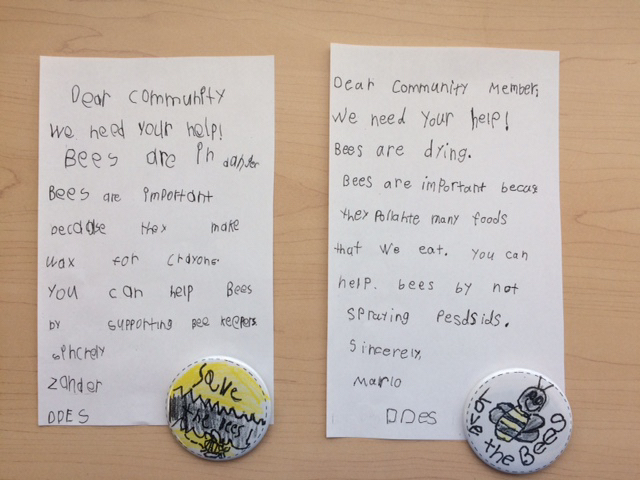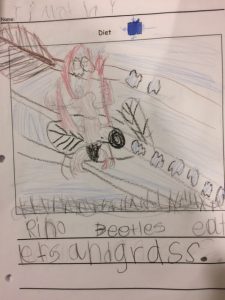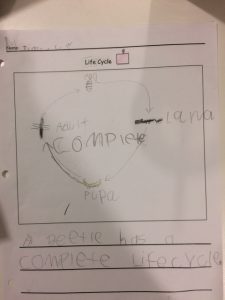Save the Bees: Kindergarten Expedition
Using High Quality Writing To Protect the Insects We Love
After a year in the life of entomologists, my Kindergarten students were faced with a startling fact: Bees, one of the insects that we studied closely and cared deeply for was in serious danger. Bees are a vital connection in our world’s food chain, and this problem not only affected us, but could damage our entire world, and we needed help from others in our community. This driving force led us to our final guiding question of the year, “How can we help bees?”. Our students knew they had the information and the passion to get their point across to the people of Denver, but how could we communicate and persuade people, especially adults, to actually do something about it?
Writing for others: What do I need for my audience to read my writing?
Before we launched our final product, Kindergarten students spent months diving into the idea of high-quality writing. Using our standards as a backbone, students were inspired by the books they read to become authors of readable texts. Through our expert insect case study, we worked to craft our own nonfiction books about our insects. We focused on the main components in sentences that allow others to read and understand ideas:
- Capitalize the first word in a sentence and the pronoun I, and include lowercase letters for all other letters.
- Recognize ending punctuation and use it appropriately to end sentences. (1st grade standard)
- Spell untaught words phonetically, drawing on phonemic awareness and spelling conventions. (1st grade standard).
- Include spaces between written words.
In our writing block, we consistently synthesized writing standards with our insect expedition to give purpose to our list of lengthy writing conventions. Breaking each concept down, students explored models, practiced and applied these skills. This allowed students to have a “why” behind their work- they were teaching others and wanted others to be able to read and learn from their writing.
Through student checklists, feedback and revision, students took their writing through the process and were able to publish books to share with families during our Student-led conferences. This also allowed for reflection on our process, and goal setting for next steps as writers.
Learning to write letters: Applying conventions to send a message.
With convention skills under our belts, Kindergarten writers dove into the world of letter writing. After dissecting the 4 main parts of a letter, we used our knowledge of writing high quality sentences to write messages for people that they could read. Since the purpose of a letter is to share your words without being present, students knew this was the perfect way to showcase the work they had been doing as authors of readable, high quality sentences this year. We started small, by writing letters to crew members to share some love, and built to writing letters to our families to invite them to our student-led conferences.
DEAR COMMUNITY MEMBER: Letters can change minds.
As our crew was blooming as letter writers, students were also diving deep into our final case study: Bees. In our research, students worked to uncover facts about this insect to answer our first guiding question: “How do bees help us?”. With a combination of high quality anchor texts, expert visitors and lessons based in primary learning principles, students discovered three main ways bees support humans: through honey production, wax creation, and most importantly, through their role as pollinators.
Pollinators and Experts
As we watched Disney’s documentary on Pollinators- Wings of Life- our crew learned how important bees are as pollinators. At least 30 percent of the world’s crops and 90 percent of our wild plants to depend on the pollination efforts of our bees. This documentary also shined light on the fact that while humans need bees, they are also a major factor in the bee population rapid decline. With this information and a simple message from a local beekeeper expert, YOU can help by sharing your ideas and persuading others, we knew exactly how to synthesize our work as entomologists and authors: We would write letters to our Denver community members to ask them to help us save our bees.
With this charge, we invited a local writing expert to share information on how to craft letters to opinion letters that would persuade people to agree with our plea.
Former Department of Education representative, Taylor Stanek, came in to explain his process of writing persuasive letters to congress and connects this to the work we are about to embark on. Kindergarten writers set to work drafting their own letters, working to include conventions, factual information gathered during our research, and 2nd grade writing standards: Write opinion pieces in which they introduce the topic or book they are writing about, state an opinion, supply reasons that support the opinion, use linking words (e.g., because, and, also) to connect opinion and reasons, and provide a concluding statement or section.

Final Product
Through the writing process, students drafted, revised, and published letters to our community members to share our opinions about saving bees We knew our words had power, but our crew also wanted to do more. While writing our letters, we also created bee inspired buttons to send our message, which we would attach to our final products to draw attention and raise funds for our insect.



